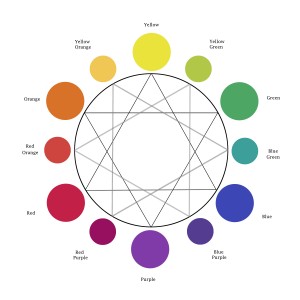Controlling Color Using
Tertiary Colors
Control your mixtures with a better understanding of the color wheel
. Most colors of a painting are not colors right out of the tube. They have to be modified. As the artist we modify the value, intensity(chroma) or the hue. Sometimes we modify all three today we are going to talk about using tertiary colors to lower or “gray down” a color’s intensity. Grayed or colors of lower intensity are important way of controlling you color. The more intense colors catch more attention when they are surrounded by colors with lower intensity. 80% percent of you colors in representational painting will contain colors of lower intensity or chroma another words “grayed” colors.
Now when I say “grayed” I am not talking about battle ship grey. I am talking about any color not being at it’s most intense shade. Below are some wonderful grayed colors. Earth tones in this example would be included with grayed colors. Grayed colors will give you paintings more variety and better cohesion.
Assorted swatches of Grayed color
Colors in nature are rarely straight out of the tube. Your primary and secondary colors are too intense to look natural. When painting, you are constantly modifying your colors and graying their intensity to create paintings that are harmonious.
First, lets look at the definitions of color.
Primary Colors – These colors cannot be mixed. They are the colors from which all other colors are made. The primary colors are red, yellow, and blue.
Secondary Colors – These colors are mixed from the primary colors. The secondary colors are orange, green, and purple.
Tertiary Colors – These colors are the steps between the primary and secondary colors. The tertiary colors are red orange, yellow orange, red purple, blue purple, yellow green, and blue green.
Complimentary Colors – Colors directly opposite one another on the color wheel. The compliment of red is green. The compliment of blue is orange.
Analogous Colors – Colors near one another on the color wheel. Analogous colors of red are purple and orange. Analogous colors of green are yellow and blue.
Each color has three characteristics.
Hue– The hue of a color is what color family the color belongs to. Is it red, yellow, blue, green, orange, or purple?

Value – How dark or light a color is.

Chroma – Is the intensity of a color, how bright or dull a color is.

Grays are essential to give your painting structure and depth.
Grays are more than those neutral battleship grays. Every color has its highest saturation point or intensity. As the intensity of a color drops, it is referred to being “grayed down”. Browns are actually dark reds or oranges, where the intensity and value have been lowered.
Once you mixing colors you will want to use tertiary colors all those wonderful colors between the primary and secondary colors. Just as with other colors you gray them down with their compliment. The compliment of a tertiary color will always be straight across from the color wheel and will always be another tertiary color ex: The compliment of “Blue Green” is “Orange Red”. Notice the compliment of “Blue Green” is easy to remember if you find the compliment of each color named in the color description(Compliment of Blue=Orange, the compliment of Green=Red, so the compliment of Blue Green is Orange Red)
use this method to find the compliment of the color you are mixing. It will save you time from having to constantly look at the color wheel.
Graying color using Tertiary Colors
Red Violet and Yellow Green
Red Orange and Blue Green
Yellow Orange and Blue Violet
So if you are using alizarin crimson which is a Red Violet and need to knock down the intensity and you don’t want it to change it’s hue too much add it’s compliment Yellow Green to the mixture. Learn your tertiary colors to have more control over you color mixtures.
by Kevin McCain
To learn more about painting visit
Kevin McCain Studios Art Classes
For information on Painting Workshops Visits Kevin McCain Studios
To see demonstrations on mixing colors view my You Tube Channel Kevin McCain Studios
Color Mixing Video below
Mixing Colors Using Split Primary Palette

